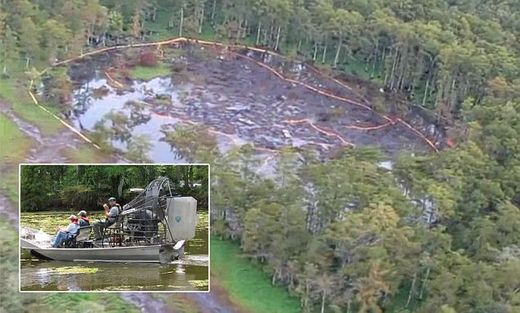The road was built as a place for parking excavators that will be used in the pending cleanup of the sinkhole, which emerged Aug. 3 in swamps between the Bayou Corne and Grand Bayou areas on property owned by Texas Brine Co., parish officials said in a blog post.
The sinkhole - filled with a liquid mixture of brine, mud, vegetative matter and other substances - has forced the evacuation of residents in 150 households in the two communities.
Excavators were not present on the road when the collapse happened, said John Boudreaux, director of the parish Office of Homeland Security and Emergency Preparedness.
The 4-acre sinkhole has undergone periodic edge collapses and has gradually become wider as the saturated soil on the edge falls into the slurry hole. Estimates before the most recent collapse put the sinkhole's width at 475 feet.
State Department of Natural Resources and Texas Brine officials have said the sloughing-off process is expected to continue as the hole finds its level and becomes shallower.
But those collapses have sometimes had dramatic results, such as the collapse last month that pulled down a tree and a boat. Two cleanup workers in the boat escaped before it went down.
The latest collapse, which took down an area 30 feet by 50 feet, happened on the southeast rim of the sinkhole, which had seemed stable until part of it sloughed off Tuesday, parish officials said.
Other developments regarding the sinkhole emergency have emerged in recent days, state and parish officials said:
- Sonar testing results of a damaged Texas Brine salt cavern and samples of material found in the cavern are being analyzed to better understand what happened to the cavern suspected as the cause of the sinkhole.
- Testing of hydrocarbon liquids from a Texas Brine investigatory well into the cavern may provide a definite link between the cavern and the sinkhole.
- Another location where natural gas bubbles to the surface of area waterways emerged and samples of its gas emissions have been captured for testing.
The company said the findings indicated "some type of dense material has fallen to the bottom of the cavern."
Parish and Louisiana Department of Natural Resources officials are trying to get a better idea about the nature and amount of material found Monday inside the 20-million-barrel salt cavern, said Patrick Courreges, DNR spokesman.
Also, Boudreaux said Tuesday that a sonar scan of the salt cavern has been completed but results were still being analyzed.
Sonar tests of the cavern were conducted through the investigatory well into the cavern. Texas Brine's contract driller finished the well Saturday, enabling experts to test the cavern's depth.
Courreges said Texas Brine and Office of Conservation personnel are conducting independent tests of samples taken from the material in the cavern. Texas Brine said the material is not consistent with brine operations.
Courreges also said the Office of Conservation is still trying to determine what link may exist between the cavern damage and the sinkhole. The underground cavern, shaped like a narrow, upside-down flower vase, extends from a depth of 3,400 feet to a depth of 5,650 feet underground. Its edge is about 200 feet southeast of the sinkhole.
DNR scientists have said they suspected that the cavern failed, allowing its brine contents to gush out and open up the sinkhole.
The cavern was hollowed out of the 1-mile by 3-mile Napoleonville Dome after nearly three decades of use for brine production. The dome is a solid salt formation that emerged from deeper deposits left by ancient seas and has been used for oil and gas exploration, brine production and hydrocarbon storage for decades.
Chris Piehler, Louisiana Department of Environmental Quality Inspection Division administrator, said this week that samples pulled from the investigatory well may enable investigators to make a connection between the cavern and the sinkhole.
After Texas Brine drillers broke through the cavern roof Saturday night, they hit natural gas and hydrocarbon liquids that Piehler said Monday were in the "diesel range."
He said DEQ collected samples of the gas and the hydrocarbon liquids and plans to do "fingerprinting" analysis of the liquids to compare them with the diesel range hydrocarbons previously collected from the surface of the sinkhole.
"That would make the definite connection analytically," Piehler said.
The parish, DNR, other state agencies and a scientific working group are investigating not only the sinkhole but also natural gas bubbles in area waterways and tremors in the Bayou Corne area that preceded the sinkhole by two months
Another bubbling spot was found in a waterway along Bayou Drive in Pierre Part and is being tested, parish officials said Wednesday.




Not looking good for that area.
Not looking good
Cheers